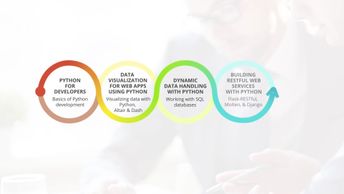Final Exam: Data Visualization for Web Apps Using Python - accept user input using Dash components
- apply logistic regressions to categorical data
- compare and contrast date inputs using date pickers
- compare and contrast date inputs using date pickers and strings
- compare and contrast date inputs using strings and date pickers
- configure a multi-tab Dash application
- contrast strip plots and swarm plots
- contrast swarm plots and strip plots
- create a basic bar chart with Altair
- create a callback to add interactivity to charts
- create a Dash app
- create a gauge updated using a spin button
- create a map of the United States and plot state-specific information using markers and choropleth maps
- create an HTML button to embed in apps
- create an ordinary bar chart using the Plotly Express library
- create a user input form with validation
- create Boolean toggle switches
- create custom figure-level and axis-level strip plots
- create figure-level and axis-level KDE curves
- create histograms for univariate data
- create univariate KDE curves and cumulative distributions
- create various customized area charts
- create various customized area charts such as area charts with multiple categories, streamgraphs, and trellis area charts
- customize callbacks for more complex interactivity
- customize dropdowns using multi-select
- customize histograms using the distplot() function
- customize various aspects of a chart such as the axis ticks, legend, and title using various functions
- customize various aspects of a chart such as the axis ticks, legend, and title using various functions such as configure_title() and configure_legend()
- define gauge properties
- enhance bar charts by adding rules representing the mean or median of a distribution, conditional formatting, and creating stacked bar charts
- execute operations on time series data
- generate a variety of box plots such as plain box plots, box plots with categorical color bars, and box plots with continuous color bars
- generate heat maps to visualize data in the form of a grid
- identify attributes of a strip plot
- illustrate some of the interactive features in line charts
- implement bar charts, KDE curves, and rug plots
- implement figure-level and axis-level scatter plots
- install Dash using the pip package installer
- install the necessary Python modules to work with Seaborn
- perform operations based on user input
- perform operations on time series data
- produce basic bar charts such as bar charts with labels and bar charts with the bars sorted in an ascending or descending order
- produce Gantt charts
- produce Gantt charts to visualize activities, tasks, or events against time
- produce world maps using data in the topo JSON format
- produce world maps using data in the topo JSON format and plot points on the map by specifying the latitude and longitude coordinates
- remove limits on dataset size set by Altair
- remove limits on dataset size set by Altair by default
- represent bivariate visualizations with color coding and grouped charts
- select values using basic dropdowns
- use basic dropdowns to select values
- use the distplot() function for customizing histograms
- use the pip package installer to install Dash
- verify the correct Python version is installed on your system, run Jupyter notebook, and install Altair
- visualize bivariate histograms and KDE curves
- visualize data and identify the relationships between variables using scatter plots
- visualize data and identify the relationships between variables using scatter plots and create a scatter plot where the color of the data points represent a variable
- visualize data using grouped bar charts and stacked bar charts
- visualize data using line charts and customize various aspects of the chart such as the interpolation and by adding rules to the chart
- visualize time series data using figure-level and axis-level line charts
|


